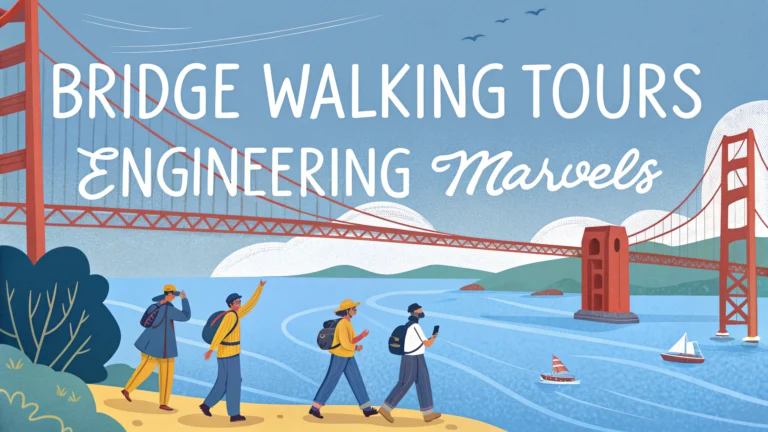Bridge walking tours offer a unique way to explore engineering marvels while getting exercise and stunning views.
Popular Bridge Walking Tours Worldwide
- Sydney Harbour Bridge Climb – 3.5-hour guided experience reaching 134m above sea level
- Brooklyn Bridge Walk – Free 1.1-mile pedestrian path connecting Manhattan to Brooklyn
- Tower Bridge Glass Floor Walk – Walk across London’s iconic bridge with views 42m above the Thames
- Golden Gate Bridge Walking Tour – 1.7-mile pedestrian path with panoramic San Francisco views
Planning Your Bridge Walk
Check weather conditions before heading out, as many bridges close during high winds or severe weather.
Wear comfortable walking shoes with good grip, as bridge surfaces can be slippery.
Bring a camera with a neck strap – bridges offer excellent photo opportunities but require secure handling.
| Best Time to Visit | What to Bring | Safety Tips |
|---|---|---|
| Early morning or sunset for photos | Water bottle, sunscreen, hat | Stay within designated paths |
| Weekdays for fewer crowds | Light jacket (bridges are windy) | Keep children close |
Self-Guided Tour Tips
- Download bridge history apps before starting your walk
- Look for informational plaques along the route
- Take photos at designated viewing points
- Walk against traffic when possible
Engineering Features to Notice
- Cable Systems: Look for main cables, suspender ropes, and anchor points
- Tower Design: Notice architectural styles and construction materials
- Expansion Joints: Find the gaps that allow bridges to expand and contract
- Support Structures: Observe different types of trusses and girders
Photography Tips
Morning light creates dramatic shadows on bridge structures.
Position yourself at the one-third points of the bridge for balanced compositions.
Include people in your shots to show scale.
Resources
- Engineering Society Walking Tours: ASCE Tours
- Bridge History Apps: BridgeSpotter, Architecture Guide
- Local Tourism Offices for Maps and Guides
Call ahead to verify operating hours and accessibility, as some bridges require advance bookings or have seasonal schedules.
Physical Preparation
Bridge walks require moderate fitness levels and proper preparation to fully enjoy the experience.
Fitness Requirements
- Ability to walk 1-3 miles continuously
- Comfortable with heights and open spaces
- Basic stamina for climbing stairs
- Balance for walking on moving structures
Special Access Options
Many bridges offer accommodations for visitors with different mobility needs.
- Wheelchair accessible viewing platforms
- Virtual reality tours for those unable to walk
- Modified routes for mobility-impaired visitors
- Guide assistance for visually impaired guests
Environmental Impact
Responsible bridge tourism helps preserve these engineering landmarks for future generations.
- Stay on marked paths to prevent erosion
- Properly dispose of waste
- Support bridge maintenance through official tour fees
- Follow local environmental guidelines
Conclusion
Bridge walking tours combine education, exercise, and entertainment while providing unique perspectives on architectural achievements. Whether choosing guided experiences or self-directed exploration, proper preparation ensures a safe and memorable adventure.
Remember to respect local regulations, maintain awareness of weather conditions, and share your experience responsibly on social media to inspire others to appreciate these engineering marvels.
FAQs
- What is the best time of year for bridge walking tours?
Spring and fall offer optimal conditions with mild temperatures and clear skies. Summer can be hot on exposed bridges, while winter may have ice hazards and limited visibility. - How long does a typical bridge walking tour take?
Most self-guided bridge tours take 2-3 hours to complete, depending on the number of bridges, photo stops, and walking pace. - Are bridge walking tours accessible for all fitness levels?
Most urban bridge walks are suitable for moderate fitness levels, with paved paths and gradual inclines. However, some historic bridges may have stairs or steep approaches. - What safety precautions should I take during a bridge walking tour?
Stay on designated pedestrian walkways, wear visible clothing, bring water, carry a phone, and avoid tours during severe weather or high winds. - What photography equipment is recommended for bridge tours?
A wide-angle lens for architectural shots, a tripod for stability, and a polarizing filter to reduce glare from water and metal surfaces are recommended. - Which famous bridges offer official walking tours?
Sydney Harbour Bridge, Tower Bridge London, Brooklyn Bridge NYC, and Golden Gate Bridge San Francisco offer organized walking tours with historical commentary. - What historical information should I research before a bridge tour?
Research construction dates, engineering innovations, historical significance, architectural style, and any major events associated with each bridge. - How can I identify different bridge engineering styles?
Look for key features like suspension cables, arch supports, truss patterns, or cantilever designs. Each style represents different engineering solutions for spanning distances. - What should I bring on a self-guided bridge walking tour?
Bring comfortable walking shoes, weather-appropriate clothing, water, snacks, map/mobile device, camera, and bridge tour information or guidebook. - Are there specific viewing points I should look for during bridge tours?
Look for designated viewing platforms, nearby parks, or elevated areas that offer panoramic views of the bridge structure and surrounding landscape.








